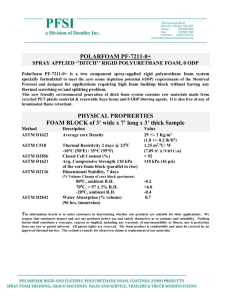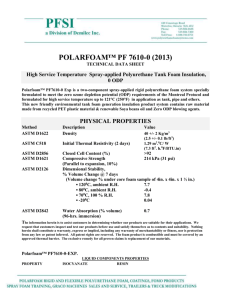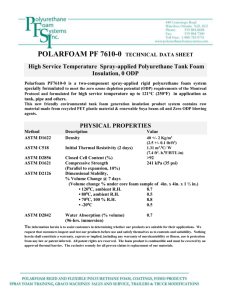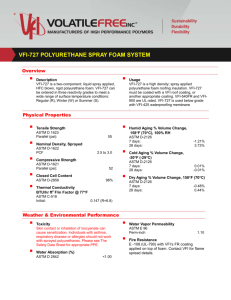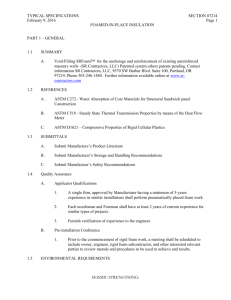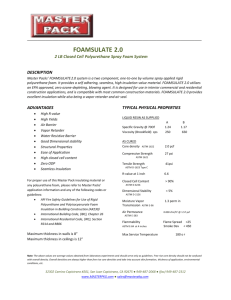high performance spray foam insulation offers more
advertisement
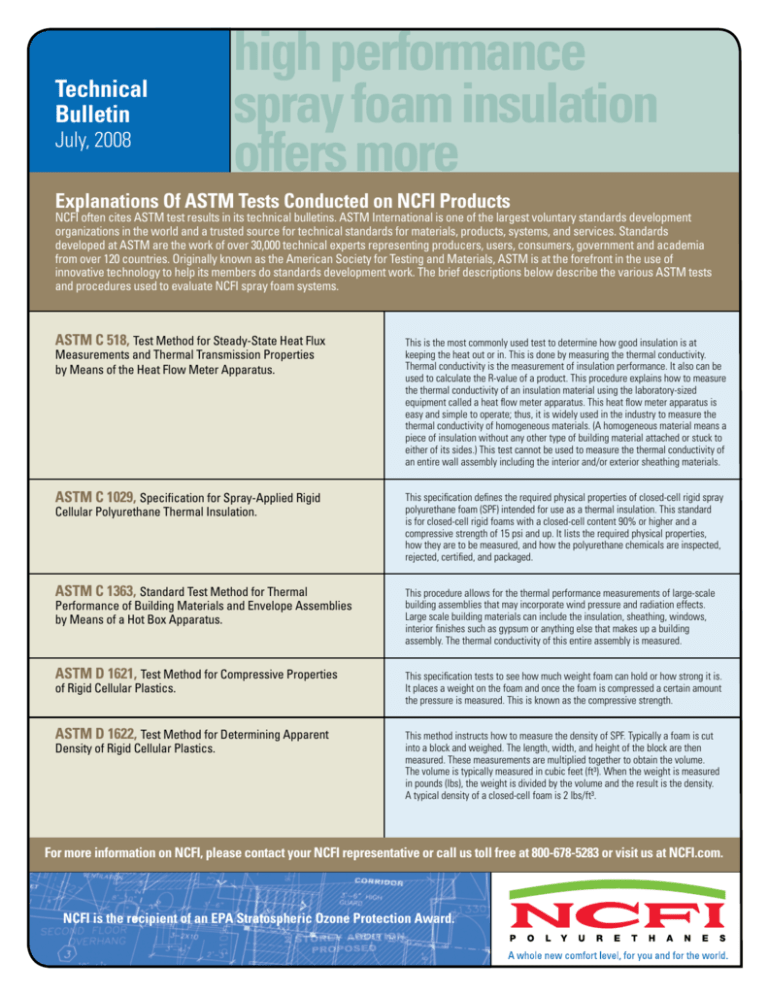
Technical Bulletin July, 2008 high performance spray foam insulation offers more Explanations Of ASTM Tests Conducted on NCFI Products NCFI often cites ASTM test results in its technical bulletins. ASTM International is one of the largest voluntary standards development organizations in the world and a trusted source for technical standards for materials, products, systems, and services. Standards developed at ASTM are the work of over 30,000 technical experts representing producers, users, consumers, government and academia from over 120 countries. Originally known as the American Society for Testing and Materials, ASTM is at the forefront in the use of innovative technology to help its members do standards development work. The brief descriptions below describe the various ASTM tests and procedures used to evaluate NCFI spray foam systems. ASTM C 518, Test Method for Steady-State Heat Flux Measurements and Thermal Transmission Properties by Means of the Heat Flow Meter Apparatus. This is the most commonly used test to determine how good insulation is at keeping the heat out or in. This is done by measuring the thermal conductivity. Thermal conductivity is the measurement of insulation performance. It also can be used to calculate the R-value of a product. This procedure explains how to measure the thermal conductivity of an insulation material using the laboratory-sized equipment called a heat flow meter apparatus. This heat flow meter apparatus is easy and simple to operate; thus, it is widely used in the industry to measure the thermal conductivity of homogeneous materials. (A homogeneous material means a piece of insulation without any other type of building material attached or stuck to either of its sides.) This test cannot be used to measure the thermal conductivity of an entire wall assembly including the interior and/or exterior sheathing materials. ASTM C 1029, Specification for Spray-Applied Rigid This specification defines the required physical properties of closed-cell rigid spray polyurethane foam (SPF) intended for use as a thermal insulation. This standard is for closed-cell rigid foams with a closed-cell content 90% or higher and a compressive strength of 15 psi and up. It lists the required physical properties, how they are to be measured, and how the polyurethane chemicals are inspected, rejected, certified, and packaged. ASTM C 1363, Standard Test Method for Thermal This procedure allows for the thermal performance measurements of large-scale building assemblies that may incorporate wind pressure and radiation effects. Large scale building materials can include the insulation, sheathing, windows, interior finishes such as gypsum or anything else that makes up a building assembly. The thermal conductivity of this entire assembly is measured. Cellular Polyurethane Thermal Insulation. Performance of Building Materials and Envelope Assemblies by Means of a Hot Box Apparatus. ASTM D 1621, Test Method for Compressive Properties of Rigid Cellular Plastics. ASTM D 1622, Test Method for Determining Apparent Density of Rigid Cellular Plastics. This specification tests to see how much weight foam can hold or how strong it is. It places a weight on the foam and once the foam is compressed a certain amount the pressure is measured. This is known as the compressive strength. This method instructs how to measure the density of SPF. Typically a foam is cut into a block and weighed. The length, width, and height of the block are then measured. These measurements are multiplied together to obtain the volume. The volume is typically measured in cubic feet (ft³). When the weight is measured in pounds (lbs), the weight is divided by the volume and the result is the density. A typical density of a closed-cell foam is 2 lbs/ft³. For more information on NCFI, please contact your NCFI representative or call us toll free at 800-678-5283 or visit us at NCFI.com. NCFI is the recipient of an EPA Stratospheric Ozone Protection Award. Technical Bulletin July, 2008 ASTM D 1623, Test Method for Tensile and Tensile Adhesion This test lets you know how much a material resists being torn apart (Tensile) and how much a material resists being ripped off another object (Tensile Adhesion). The amount of force needed to pull the foam off a piece of wood, for example, is its tensile adhesion strength. ASTM D 2126, Test Method for Response of Rigid Cellular This method measures how SPF responds to humidity and temperature. It is commonly referred to as the dimensional stability test. It exposes the foam to different humidity and temperature environments and the size and shape of the foam is measured over time. A percent change in size is reported as the end result. ASTM D 6226, Standard Test Method for Open Cell Content Foam is made of tiny bubbles, or cells. Some cells are open and some are closed. In a cushion foam, most if not all the cells are open. In a tub full of soap bubbles, the cells of the foam are closed. With polyurethane foam, there is a mixture of open and closed cells. This method determines how many of the cells in a foam are open and how many are closed. ASTM E 84, Test Methods for Surface Burning Characteristics of Building Materials. This is often referred to as the tunnel test. A sample is applied to the top side of a 25 foot long closed tunnel. The sample is exposed to a large controlled flame at one end for a set period of time. The technician measures two things: Flame Spread – a measurement of how far the flame traveled along the sample down the tunnel in the time period, and smoke – during burning, smoke is generated and the amount of the smoke is measured. These two measurements are given a number based on a calibrated scale and reported. ASTM E 96, Test Method for Water Vapor Transmission The act of water vapor traveling through a piece of foam is called water vapor transmission (WVT). A material’s resistance to WVT is called its permeability. The higher the permeability, the quicker or easier it is for water vapor to transmit from one side to another. This test will measure the water permeability of a material. ASTM E 119, Test Methods for Fire Tests of Building This method is used to determine the fire resistive properties of building assemblies including walls, floors and roof assemblies. It is also used to qualify thermal barriers for SPF. ASTM E 283, Test Method for Determining the Rate of Air This is a laboratory test to determine the amount of air that is able to flow through building products such as polyurethane foam. Properties of Rigid Cellular Plastics (Type B Specimen). Plastics to Thermal and Humid Aging. of Rigid Cellular Plastics. of Materials. Construction and Materials. Leakage through Exterior Windows, Curtain Walls, and Doors under Specified Pressure Differences Across the Specimen. For more information on NCFI, please contact your NCFI representative or call us toll free at 800-678-5283 or visit us at NCFI.com. high performance spray foam offers more NCFI Polyurethanes, A Division of BMC, P.O. Box 1528, Mount Airy, NC 27030 © NCFI Polyurethanes 2008
